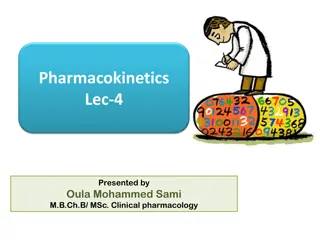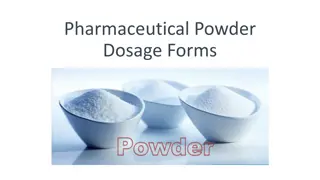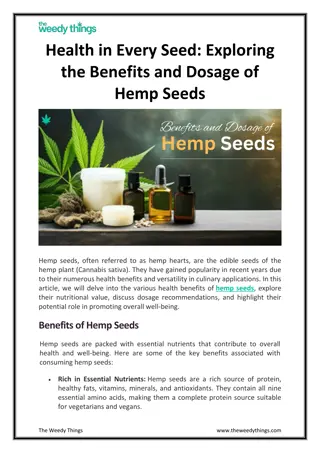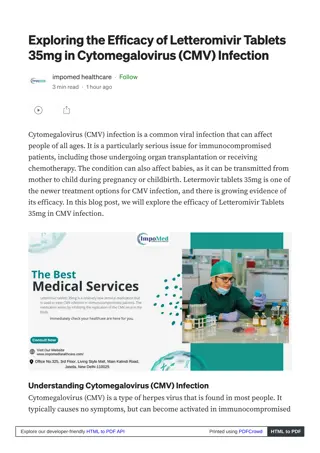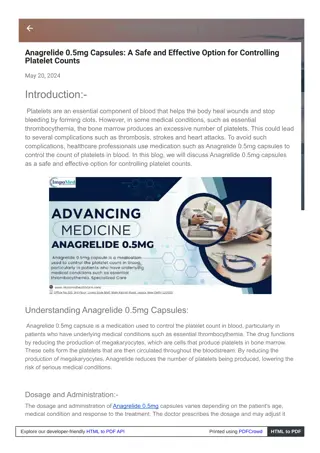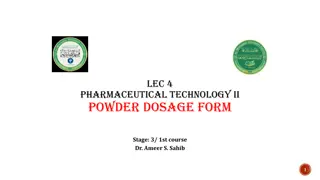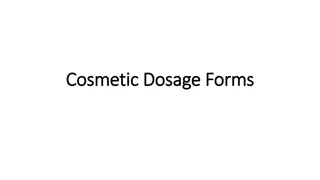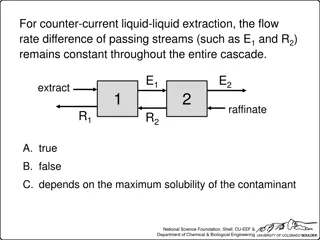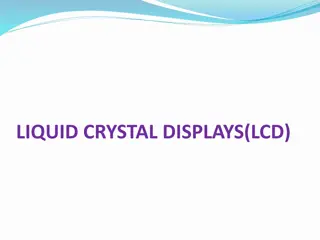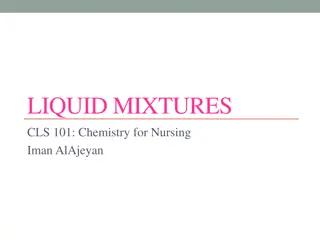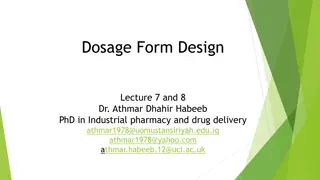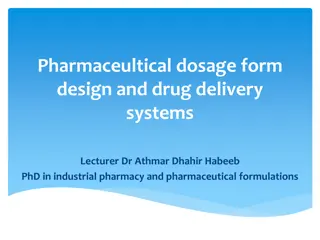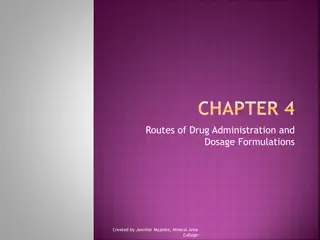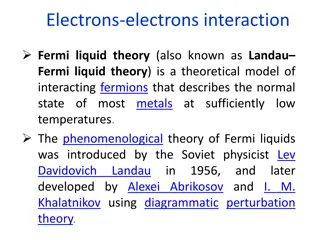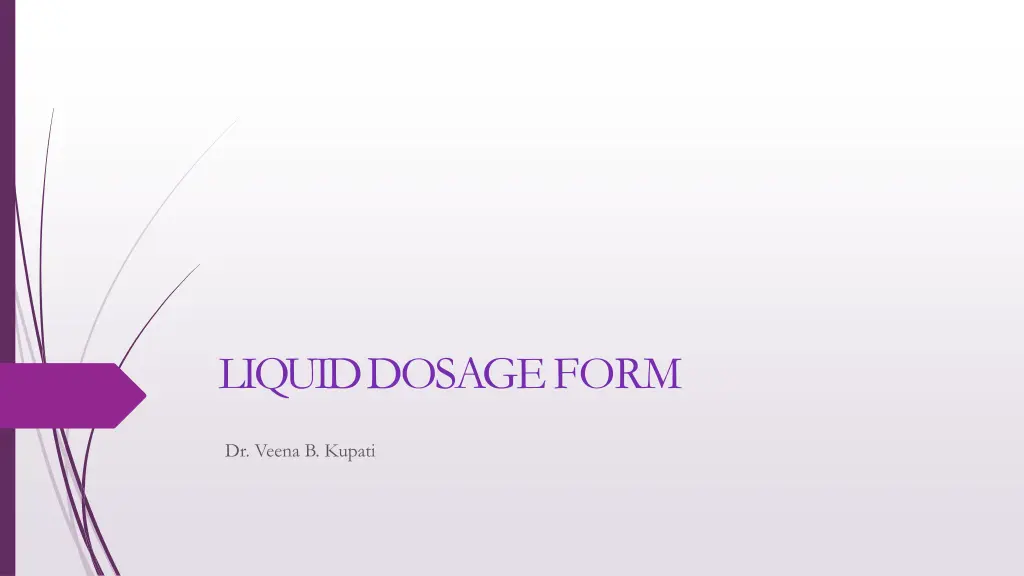
Understanding Liquid Dosage Forms in Pharma
Explore the world of liquid dosage forms with Dr. Veena B. Kupati, including preparation methods, classifications, advantages, and disadvantages. Learn about monophasic liquids and their internal use, such as syrups, in pharmaceutical applications.
Uploaded on | 0 Views
Download Presentation

Please find below an Image/Link to download the presentation.
The content on the website is provided AS IS for your information and personal use only. It may not be sold, licensed, or shared on other websites without obtaining consent from the author. If you encounter any issues during the download, it is possible that the publisher has removed the file from their server.
You are allowed to download the files provided on this website for personal or commercial use, subject to the condition that they are used lawfully. All files are the property of their respective owners.
The content on the website is provided AS IS for your information and personal use only. It may not be sold, licensed, or shared on other websites without obtaining consent from the author.
E N D
Presentation Transcript
LIQUID DOSAGE FORM Dr. Veena B. Kupati
Liquid dosage forms Liquid dosage form is one kind of classification of dosage form on the base of physical state. Liquid form of a dose of a drug used as a drug intended for administration or consumption or medication
Preparation of liquid dosage form Methods of preparation By Dissolving the active substance in an aqueous or non aqueous. Alcohol, Either, Glycerin Solvents. By Suspending the drug in appropriate medium By Incorporating the drug substance into an oil or water phase.
Classification of liquid dosage forms Monophasic liquid Biphasic liquid
Advantages and disadvantages of liquid dosage form Advantages: Very useful for those patients who have trouble swallowing. The rate of absorption of the liquid dosage form is so faster than the solid dosage form. Liquid dosage forms are flexible to take a proper those than solid dose. Disadvantages: It needs a lot of special storage conditions. Affected by microorganisms: Due to the presence of sweetening and flavoring agents. Less stable than other doses. The problem of container breakage.
Monophasic liquid dosage form Monophasic liquid dosage forms are represent by true or colloidal solutionContains only one phase, no matter components might be minimum 2 or more than 2. Large quantity Solvent and Small quantity Solute Solute might be one or more than one. A solution is homogenous because the solute is an ionic or molecular forms of subdivision. In case of colloidal solutions, the solutes are present as aggregates although they cannot be seen by necked eye or ordinary microscope. It is sub classified as I) Internal Use, II) External use This is the most simplest form of presenting medication for rapid absorption of the drug. They are dispensed for various purposes
Monophasic liquids for Internal use Syrup It is a concentrated or saturated solutions of sucrose in purified water. The concentration of sucrose is 66.7% w/w & due to that it is a viscous preparations. The syrup which contains medical substance called as a medicated syrup & those containing aromatic or flavored substance known as a flavored syrup. Importance of syrup It retards oxidation because its partly hydrolyzed into reducing sugar. It prevents decomposition of many vegetable substance because its have high osmotic pressure which prevent the growth of bacteria. They are palatable due sweet taste.
Elixirs It is clear, sweetened, aromatic, hydroalcholic preparations meant for oral use. The medicated elixirs are generally contained potent drug like as antibiotics, antihistamine or sedative , where as non medicated elixirs contained flavoured. The composition of elixirs contained mainly as Ethyl alcohol (active ingredients) Water Glycerin or propylene glycol Colouring agent Flavouring agent Preservative.
Linctus Linctuses are viscous liquid preparations that s are used for the treatment of cough. They contain medicaments which have demulcent, sedative, expectorant action. They are taken in small doses without diluting with water to have prolonged effect of medicines. Simple syrup is used as a vehicle for most of the linctuses. Tolu syrup is preferred in certain cases because of its aromatic odour & flavour. Moreover it have a mild expectorant action
Drops Drops are liquid preparations meant for oral administration. The oil soluble vitamins, such as vitamin A & D concentrates in fish liver oil are presented as drops for administration. Since these preparations contain potent medicaments, the dose must be measured accurately The following two methods are commonly used for this purpose. Use of a dropper which is accurately graduated in fractions of a milliliters. Use of a pre calibrated dropper.
Monophasic liquids for External use Lotions Lotions are usually aqueous, alcoholic or oily liquid preparations. They are intended for external application without friction or rubbing to the affected area Usually applied with the help of some absorbent material such as cotton wool or gauze. It is generally used to provide cooling, soothing and protective & antiseptic action.
Gargles Gargles are aqueous solutions used for treating throat infection (pharynx and nasopharynx part) Supplied in concentrated forms with directions of dilution with warm water before use They are used into intimate contact with the mucous membrane of throat for few seconds, before they are thrown out of the mouth. They are used to relieve soreness in mild throat infection. They are also used for their antiseptics, antibiotics and/or anesthetics
Mouth wash Mouth wash are aqueous solutions with pleasant or acceptable taste & odor These are used to make clean & deodorize the buccal cavity or used for oral hygiene and to treat infections of the mouth. They mainly contain antibacterial agent, alcohol, glycerin, sweetening agent, flavoring agent & coloring agent
Throat paints Throat paints are viscous liquid preparations used for mouth and throat infections Glycerin is commonly used as a base because being viscous it adheres to mucous membrane for long period and it possess a sweet taste.
Sprays Sprays are the preparations of drugs in media which may be aqueous, alcoholic, or glycerin. They are applied to the mucous membrane of throat or nose with an atomizer. The throat sprays must be sprayed from a special type of atomizer known as a nebulizer, which removes the large droplets by baffling system. Only precaution should be taken that the fine droplet will used to easily reach the lungs.
Inhalations These are liquid preparations containing volatile substance & are used to relieve decongestion & inflammations of respiratory tract. The volatile substance in inhalations would be volatile at room temperature so that they should be placed on some adsorbent pad or handkerchief. In some cases inhalations will added to hot water (65 0 c) then vapors will inhaled.
Nasal drops Drugs in solution may be instilled into the nose from a dropper or from a plastic squeeze bottle. The drug may have a local effect, e.g. antihistamine, decongestant. Alternatively the drug may be absorbed through the nasal mucosa to exert a systemic effect. The use of oily nasal drops should be avoided because of possible damage to the cilia of the nasal mucosa & if it is used for long period may reach the lungs & cause lipoid pneumonia. To avoid that Nasal drops are prepared so that they are similar in many respects to nasal secretions, so that normal ciliary action is maintained thus aqueous nasal solutions usually are isotonic and slightly buffered to maintain a pH of 5.5 to 6.5.
Eye preparations Eye drops: Sterile, aqueous/oily solutions or suspensions intended for instillation in eye sac. Eye drops may contain buffers, stabilizing agents, dispersing agents, solubilizing agents, anti-oxidants & agents required for tonicity/ viscosity adjustment Single dose container should not contain anti-microbial preservative. In case of multi dose container a dropper should be supplied with it for administration. Maximum size of such containers is 10 ml. Eye lotions: These are the aqueous solutions used for washing the eyes. These are supplied in concentrated forms & are required to diluted with warm water immediately before use. They should be free from foreign particles to avoids irritation to the eye. They are required to prepared fresh & should not be stored for more than two days to avoid microbial contaminations. Ear drops: These are the solutions of drugs that are instilled into ear cavity with the help of dropper. These are generally used for cleaning the ear, softening the wax & for treating the mild infections. The solutions is generally prepared in water, glycerin, propylene glycol & dilute alcohol.
Biphasic liquid dosage form Biphasic liquid dosage form contain 2 phases. This includes undissolved drug and the solvent system(vehicle). Undissolved phase is distributed throughout a vehicle and intended for oral administration. In this preparation this phase is called dispersed phase and the vehicle is called dispersedmedium . It is also called internal phase or external phase respectively.
Cont.. Need of biphasic liquid dosage forms The medicaments are poorly soluble in the solvent medium. Medicaments from the dispersed phase of the system which might be either solid or liquid. When solid medicament is distributed in the dispersion medium , the system formed is called suspension. When liquid medicament is distributed in the dispersion medium , the system formed is called emulsion.
These two highly unstable systems are made stable by employing various pharmaceutical aids like; suspending agent, emulsifying agent. They are categorized as coarse particles, usually 1 to 100 microns in size Dispersion containing particles of smaller size are called fine dispersion and if the particles are in the colloidal range ( < 1 micron ), they are termed magmas.
Types of Biphasic liquids There Are Two Types Of Biphasic Liquid SUSPENSION Enemas, Lotion, Inhalation, Aerosols, Eye Drop. EMULSION Liniment, Lotion, Enemas
Suspension Heterogeneous biphasic dosage form. Solid is dispersed in liquid medium. Dispersed phase, dispersion medium. Properties Rapid settling. Easily redisperdible. pourable. If parenteral flow through syringe needle. If external spread easily Pleasing in colour , odour, appearance.
Physical features of Dispersed phase of Suspension Good pharmaceutical suspensions, the particle diameter is between 1 to 50. Particle size reduction is generally accomplished by dry-milling prior to the incorporation of the dispersed phase into the dispersion medium. One of the methods of producing fine drug powders of about 10 to 50 m size is micro pulverization. For still finer particles, under 10 m, the process of fluid energy grinding, sometimes referred to as jet-milling or micronizing.
Dispersion medium Suspending agents are added to the dispersion medium to lend its structure to assist in the suspension of the dispersed phase. Examples Carboxymethylcelulose Methylcellulose Microcrystalline cellulose Polyvinyl pyrolidone Xanthan gum Bentonite
Emulsion An emulsion is a dispersion in which the dispersed phase is composed of small globules of liquid distributed through a vehicle in which it is immiscible. The liquid which is converted into minute globules is called as dispersed phase & the liquid in which the globules are dispersed is called the continuous phase. Dispersed Phase (Internal phase) Continuous Phase (External phase) An emulsion is a thermodynamically unstable system consisting of at least two immiscible liquid phases one of which is dispersed as globules in the other liquid phase stabilized by a third substance called emulsifying agent. The globule size in emulsion varies from 0.25 to 25 m .
Classification Based on dispersed phase Oil in Water (O/W): Oil droplets dispersed in water Water in Oil (W/O): Water droplets dispersed in oil. Based on size of liquid droplets 0.01 0.2 mm Micro emulsions (Thermodynamically Stable). 0.2 50 mm Macro emulsions (Kinetically Stable)
Pharmaceutical Emulsions Lotion Liniments Creams Ointments Vitamin drop
Theories of emulsification Surface Tension Theory: lowering of interfacial tension Oriented Wedge Theory: mono molecular layers of emulsifying agents are curved around a droplet of the internal phase of the emulsion. Interfacial film theory: A film of emulsifying agent prevents the contact and coslescing of the dispersed phase.

